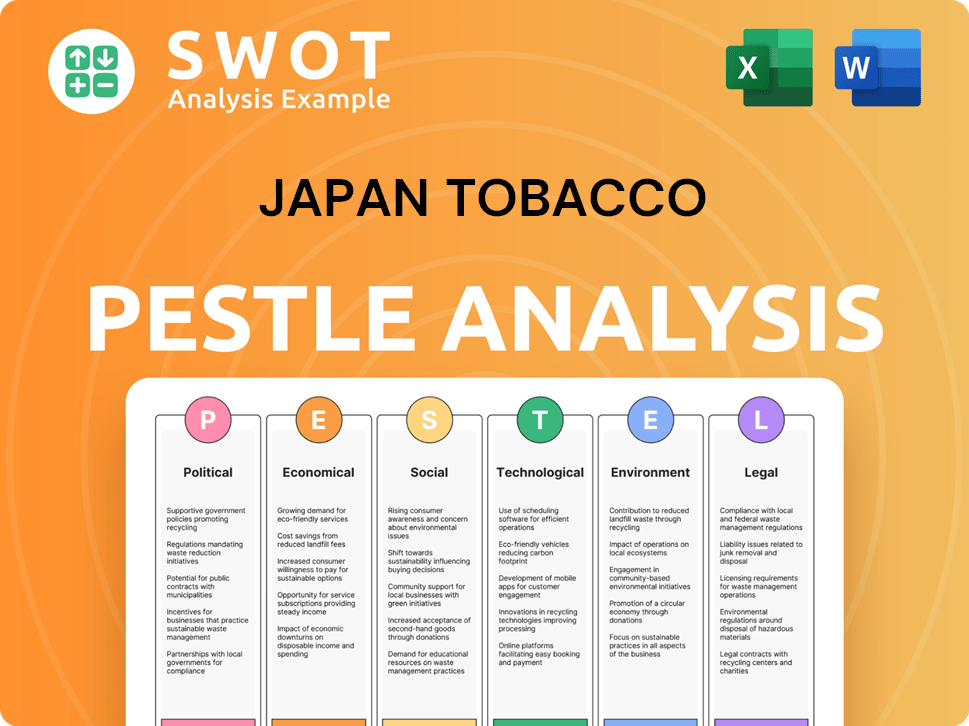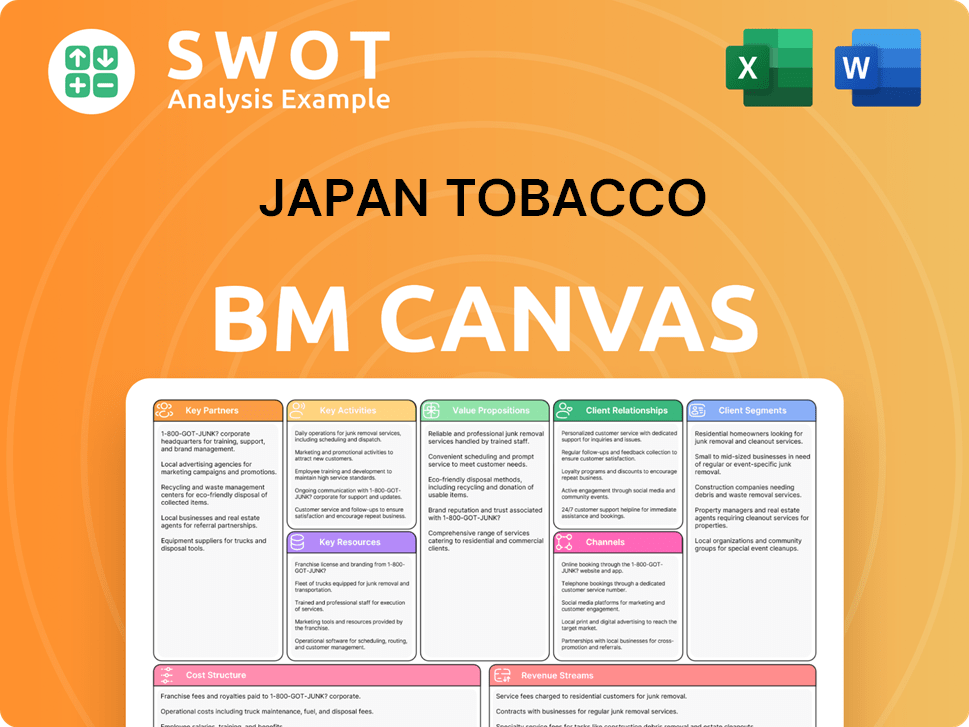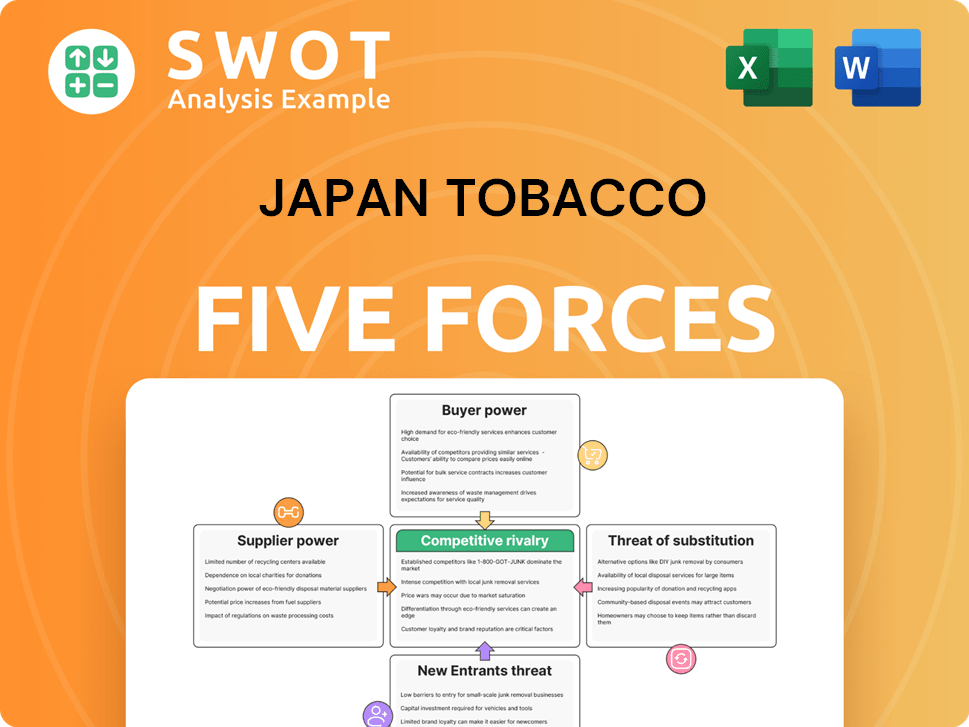Japan Tobacco Bundle
How Does Japan Tobacco Company Thrive in a Changing World?
Japan Tobacco Inc. (JT), a global powerhouse, isn't just about cigarettes; it's a diversified enterprise with significant stakes in pharmaceuticals and processed foods. Based in Tokyo, the Japan Tobacco SWOT Analysis reveals the company's strategic positioning. With its products available in over 130 markets, understanding how JT Group operates is critical for anyone interested in the global consumer goods landscape.

The recent acquisition of Vector Group Ltd. by JT Group in October 2024 for $2.4 billion, shows the company's ambition for growth. This strategic move is set to significantly boost JT's presence in the lucrative U.S. tobacco market. This expansion is a testament to JT's adaptive business model and its continued relevance in the ever-evolving tobacco industry, making it a fascinating case study for investors and industry watchers alike.
What Are the Key Operations Driving Japan Tobacco’s Success?
The Japan Tobacco Company (JTC) operates across three main business segments: tobacco, pharmaceuticals, and processed foods. The tobacco segment is the largest, focusing on the manufacture and sale of cigarettes and Reduced-Risk Products (RRPs). The company's value proposition centers on providing a diverse range of products, from traditional cigarettes to innovative alternatives, while also investing in other sectors to diversify its revenue streams.
The company's core operations are structured around these segments, with significant investment in research and development, manufacturing, and global distribution. The tobacco segment, in particular, leverages strong brand recognition and a vast distribution network to maintain its market position. The pharmaceutical and processed foods segments contribute to the company's overall financial health and strategic diversification.
The JT Group aims to expand the availability of its Ploom brand of heated tobacco products to over 40 markets by the end of 2026. This expansion is a key part of its strategy to grow in the RRP market. The company's commitment to R&D, coupled with strategic geographic expansion, aims to differentiate its offerings.
The tobacco segment involves extensive manufacturing processes and a global supply chain. This includes sourcing raw materials, manufacturing cigarettes and RRPs, and distributing products across over 130 markets. The company focuses on maintaining strong brand loyalty and pricing power to sustain its competitive edge.
In the pharmaceutical sector, the company is involved in the research, development, manufacturing, and sale of prescription drugs. Therapeutic areas include cardiovascular, renal and metabolism, immunology, and neuroscience. This segment contributes to diversification and long-term growth.
The processed food segment focuses on manufacturing and selling staple food products. This includes items like frozen noodles and okonomiyaki, as well as seasonings. This segment provides additional revenue streams and market diversification for Japan Tobacco Company.
The value proposition of the Japan Tobacco Company is centered on providing a wide range of products. This includes traditional cigarettes under brands like Winston and Camel, as well as Reduced-Risk Products (RRPs) like Ploom. The company also focuses on innovation and sustainability, such as supply chain transparency.
The company's operational processes include extensive manufacturing, global sourcing, and a vast distribution network. The company's competitive edge in combustibles is sustained by strong brand loyalty and pricing power. Strategic partnerships and investments in R&D are also key.
- Partnership with Sourcemap to enhance supply chain transparency for RRPs.
- Annual price increases of 7% outpaced its 1% annual volume growth from 2019 to 2024.
- Focus on expanding the availability of Ploom.
- Investment in pharmaceutical and processed food segments for diversification.
Japan Tobacco SWOT Analysis
- Complete SWOT Breakdown
- Fully Customizable
- Editable in Excel & Word
- Professional Formatting
- Investor-Ready Format

How Does Japan Tobacco Make Money?
The revenue streams and monetization strategies of the Japan Tobacco Company (JTC) are primarily centered on its tobacco business, with a strategic shift towards Reduced-Risk Products (RRPs). The company leverages its established global presence and brand portfolio to generate revenue from various markets. JT Group focuses on maximizing profitability in its core combustible tobacco segment while investing heavily in the growth of its RRPs to ensure long-term sustainability.
Japan Tobacco Company's financial performance is driven by its diversified revenue streams. The company's strategic investments in RRPs, such as its Ploom heated tobacco products, are designed to capture a larger share of the evolving tobacco market. The company's financial strategy includes a focus on cost management and operational efficiency to maintain profitability.
The company's revenue streams are diversified across different product categories and geographic regions. JT International's global operations contribute to the company's revenue base. The company's strategy involves a balanced approach to revenue generation, combining its core tobacco business with investments in growth areas like RRPs and other ventures.
The sale of cigarettes and other conventional combustible tobacco products generates the majority of Japan Tobacco Company's revenue. In 2023, this segment accounted for approximately 97% of total revenue. Strong brand recognition and global distribution networks support this revenue stream.
Japan Tobacco Company is investing heavily in RRPs to diversify its revenue streams. This includes heated tobacco products like Ploom. The company aims to achieve profitability in the RRP segment by 2028.
Japan Tobacco Company also generates revenue from its pharmaceutical and processed food businesses. These segments contribute a smaller portion to overall earnings compared to tobacco products.
JT Group operates globally, with revenue generated from various regions. JT International's presence in numerous countries supports this geographic diversification. The company's international footprint helps mitigate risks associated with regional market fluctuations.
Japan Tobacco Company employs various pricing strategies to maximize revenue. These strategies include premium pricing for certain brands and competitive pricing in different markets. Pricing adjustments are made to reflect market conditions and consumer preferences.
The company utilizes extensive distribution and retail networks to ensure product availability. This includes partnerships with retailers and direct distribution channels. Efficient distribution is crucial for reaching consumers in various markets.
The financial performance of Japan Tobacco Company reflects its strategic focus on both its core business and emerging opportunities. For the fiscal year ended December 2024, revenue increased by 10.9% to JPY 3,149.8 billion. Revenue for Q1 2025 increased by 11.7% to JPY 827.0 billion. The company forecasts revenue to increase by 3.9% to JPY 3,273.0 billion for the full year 2025. The company's investment in RRPs is significant, with plans to spend JPY 450 billion (approximately $2.9 billion) between 2024 and 2026. For more insights into the history of the company, you can read Brief History of Japan Tobacco.
Japan Tobacco Company's financial strategies and performance are supported by the following key elements:
- Revenue Growth: Revenue increased by 10.9% in FY2024 and is projected to grow by 3.9% in FY2025.
- RRP Investments: The company is investing JPY 450 billion in RRPs between 2024 and 2026.
- RRP Performance: RRP-related revenue increased by approximately 22% year-on-year in Q3 2024.
- Market Expansion: Expansion of Ploom's availability and development of new devices and stick ecosystems.
- Profitability Goals: Aiming for profitability in the RRP segment by 2028.
Japan Tobacco PESTLE Analysis
- Covers All 6 PESTLE Categories
- No Research Needed – Save Hours of Work
- Built by Experts, Trusted by Consultants
- Instant Download, Ready to Use
- 100% Editable, Fully Customizable

Which Strategic Decisions Have Shaped Japan Tobacco’s Business Model?
The Japan Tobacco Company (JTC), also known as JT Group, has a significant presence in the global tobacco industry. Its operations span across numerous countries, making it a key player in the Japanese cigarette market and beyond. The company's strategic moves and competitive advantages are crucial to understanding its position in the industry.
A key aspect of Japan Tobacco Company's strategy involves navigating a complex regulatory landscape and adapting to evolving consumer preferences. This includes managing the decline in traditional combustible cigarette volumes while investing in reduced-risk products (RRPs). The company’s ability to innovate and respond to market changes is critical for its long-term success.
This analysis delves into the key milestones, strategic initiatives, and competitive strengths of Japan Tobacco Company, offering insights into its operational strategies and market dynamics. Understanding these elements is essential for anyone interested in the tobacco industry, from investors to business strategists.
One of the most significant recent milestones for JT was the acquisition of Vector Group Ltd. in October 2024 for US$2.4 billion. This acquisition significantly boosted JT's market share in the U.S. combustible market. Other notable acquisitions include Gryson NV in 2012 and the 'Natural American Spirit' cigarette business outside the US in 2016.
JT's strategic moves focus on expanding its presence in the RRP market. The company is investing heavily in its Ploom heated tobacco product. Ploom X, the latest generation of its heated tobacco product line, saw a 40% volume surge in Q3 2024. JT is also expanding its market reach, aiming to have Ploom X in 24 markets by the end of 2024.
JT's competitive advantages include a strong brand portfolio, such as Winston, Camel, MEVIUS, and LD. The company benefits from the addictive nature of tobacco products and strong brand loyalty, which contributes to its robust pricing power. JT is adapting to new trends by prioritizing investment in HTS, aiming to increase RRP-related revenue by approximately 2.5 times compared to 2023 by the end of 2026.
JT faces challenges such as declining combustible industry volumes and tightening regulations on RRPs. To counter these, the company employs robust pricing strategies in combustibles and is making substantial investments in its Ploom heated tobacco product. JT’s global footprint and brand recognition provide significant opportunities for growth, especially in emerging markets.
The tobacco industry is undergoing significant changes, with a shift towards reduced-risk products. JT's ability to adapt to these changes will be critical for its future success. The company's investments in HTS and its global presence position it well to capitalize on these trends. For more insights into how JT approaches marketing, read the Marketing Strategy of Japan Tobacco.
- JT's focus on RRPs is a key strategic move.
- The company's strong brand portfolio provides a competitive advantage.
- Geopolitical risks and regulatory changes pose ongoing challenges.
- JT is aiming to increase RRP-related revenue by approximately 2.5 times by the end of 2026.
Japan Tobacco Business Model Canvas
- Complete 9-Block Business Model Canvas
- Effortlessly Communicate Your Business Strategy
- Investor-Ready BMC Format
- 100% Editable and Customizable
- Clear and Structured Layout

How Is Japan Tobacco Positioning Itself for Continued Success?
The Japan Tobacco Company (JTC), or JT Group, holds a significant position in the global tobacco industry. As the world's fourth-largest tobacco company by volume (excluding China), it commands an estimated 18% of the global market share. Its dominance is particularly evident in its home market, Japan, where it holds a substantial 41% share of the combustible market in 2024. JT International (JTI) also maintains a robust presence in key markets such as Russia, the Philippines, and Turkey.
However, JTC faces several challenges. These include declining combustible industry volumes, increased illicit trade, rising taxes, and stricter regulations on tobacco and Reduced-Risk Products (RRPs). Geopolitical risks and currency fluctuations add further complexities to its operations and financial performance. For example, the company's 2024 financial results were significantly impacted by a JPY 375.6 billion provision for litigation losses related to a Canadian settlement.
JTC is a major player in the tobacco industry, ranking fourth globally by volume. It boasts a strong market share in key regions, including Japan, Russia, the Philippines, and Turkey. The company leverages its established brands and distribution networks to maintain its competitive edge in the Japanese cigarette market and internationally.
JTC faces headwinds such as declining combustible volumes, illicit trade, and stricter regulations. Geopolitical instability and currency fluctuations also pose risks. The company's financial performance can be influenced by litigation and settlements, as seen with the recent Canadian settlement impacting the 2024 results.
JTC aims for sustained profit growth through strategic investments and diversification. The company anticipates a 3.6% top-line growth, driven by price increases in combustibles, offsetting volume declines. Investments in RRPs are crucial to its future.
JTC is investing heavily in RRPs, committing JPY 450 billion ($2.9 billion) between 2024 and 2026, aiming for the RRP business to break even by 2028. New Ploom devices and stick ecosystems are planned for launch in 2025. Combustibles are still expected to contribute significantly to revenue.
JTC's future strategy focuses on sustainable profit growth through strategic investments and diversification, particularly in the RRP sector. The company is strategically positioning itself to navigate the evolving tobacco market. This includes launching new products and expanding its presence in the RRP category, while still capitalizing on the established combustibles market. You can learn more about JTC's plans by reading the Growth Strategy of Japan Tobacco.
- Sustained profit growth through strategic investments.
- Mid-single-digit price increases in combustibles.
- Investment of JPY 450 billion in RRPs between 2024 and 2026.
- RRP business expected to break even by 2028.
Japan Tobacco Porter's Five Forces Analysis
- Covers All 5 Competitive Forces in Detail
- Structured for Consultants, Students, and Founders
- 100% Editable in Microsoft Word & Excel
- Instant Digital Download – Use Immediately
- Compatible with Mac & PC – Fully Unlocked

Related Blogs
- What are Mission Vision & Core Values of Japan Tobacco Company?
- What is Competitive Landscape of Japan Tobacco Company?
- What is Growth Strategy and Future Prospects of Japan Tobacco Company?
- What is Sales and Marketing Strategy of Japan Tobacco Company?
- What is Brief History of Japan Tobacco Company?
- Who Owns Japan Tobacco Company?
- What is Customer Demographics and Target Market of Japan Tobacco Company?
Disclaimer
All information, articles, and product details provided on this website are for general informational and educational purposes only. We do not claim any ownership over, nor do we intend to infringe upon, any trademarks, copyrights, logos, brand names, or other intellectual property mentioned or depicted on this site. Such intellectual property remains the property of its respective owners, and any references here are made solely for identification or informational purposes, without implying any affiliation, endorsement, or partnership.
We make no representations or warranties, express or implied, regarding the accuracy, completeness, or suitability of any content or products presented. Nothing on this website should be construed as legal, tax, investment, financial, medical, or other professional advice. In addition, no part of this site—including articles or product references—constitutes a solicitation, recommendation, endorsement, advertisement, or offer to buy or sell any securities, franchises, or other financial instruments, particularly in jurisdictions where such activity would be unlawful.
All content is of a general nature and may not address the specific circumstances of any individual or entity. It is not a substitute for professional advice or services. Any actions you take based on the information provided here are strictly at your own risk. You accept full responsibility for any decisions or outcomes arising from your use of this website and agree to release us from any liability in connection with your use of, or reliance upon, the content or products found herein.